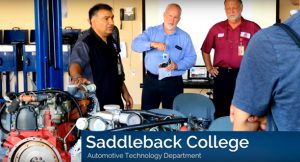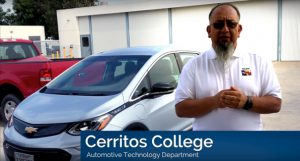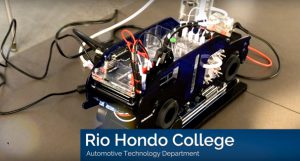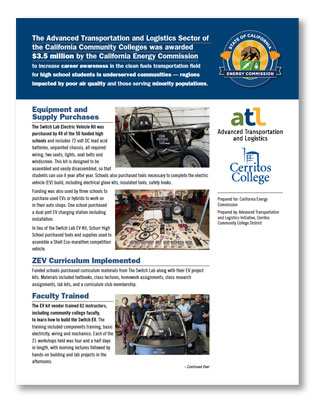 Earlier this fall, California Energy Commission and community college staff visited several colleges that received funding from the Energy Commission for a firsthand look at how those funds were impacting students across southern California.
Earlier this fall, California Energy Commission and community college staff visited several colleges that received funding from the Energy Commission for a firsthand look at how those funds were impacting students across southern California.
Members of the Energy Commission, along with CETI Sector Navigator, Peter Davis and Project Manager, Greg Newhouse, visited San Diego Miramar College, Saddleback College, Cerritos College, and Rio Hondo College on October 17 and 18. While there, they discussed topics such as:
- Student recruiting
- Job prospects for students
- Staying engaged with industry
- The future of alternative fuel vehicle training
Key Observations
Each campus made a significant impact on Tami Haas with the Fuels and Transportation Division of the Energy Commission.
“The programs were all very impressive,” Haas said. “The dedication and passion of the staff and instructors was palpable. It was good to see that all the colleges offer a dual enrollment component – and that they are reaching out to the high schools in their areas to raise awareness of the possibilities associated with alternative fuel technician employment, as well as the huge need for a skilled workforce in this field, and encouraging opportunities for making a livable wage.”
The thorough scope of college alternative fuel programs will give students a competitive advantage upon completing their coursework, noted Haas. She also observed that students can benefit from the short-term certificate programs (six to 18 months) and flexible schedules offered by many of the colleges. “This opens more opportunities for members of disadvantaged or low-income communities in the areas the colleges serve.”
Several colleges invited their industry partners to speak during the visits, giving the Energy Commission a firsthand look at how they work together.
“It appears that the colleges have established good relationships with the industries they work with, not only creating pathways to clean transportation jobs for students but pipelines of support through donations of vehicle and instructional tools and aids to community colleges,” Haas said.
Campus Highlights

Click here to watch video.
San Diego Miramar College
San Diego Miramar College (click here for video) received funding to enhance its natural gas engine training program, which included purchasing five heavy-duty natural gas engines and providing professional development for faculty.
The college’s natural gas engine technology curriculum is being re-evaluated to ensure that it is providing students with the skills they need to be successful in the job market. Newhouse said that, from what he saw, the college is well on its way to doing that.
“From the facilities themselves to the faculty, I was impressed by the detail involved in natural gas engine technology training and the integration of that training into an understanding of how the whole vehicle system operates,” Newhouse said. “Students trained through this program are well-equipped to understand and address complex vehicle maintenance issues.”

Click here to watch video.
Saddleback College
Saddleback College (click here for video) is focusing on community outreach and partnerships. The college recently hosted a National Alternative Fuel Vehicle Odyssey Day to educate the community about alternative fuel vehicles.
In addition, the college invited high school teachers and college instructors to participate in professional development at its SWITCH lab, where they built three electric vehicles over the course of a week.
Saddleback also used Energy Commission funds to purchase a Nissan Leaf, which allows them to participate in first responder alternative fuel vehicle training.
“During our time at Saddleback College, the automotive faculty demonstrated a clear path to electric vehicle technical training,” Newhouse said. “In partnership with SWITCH Lab, the faculty effectively taught, demonstrated and promoted the benefits of electric vehicle technology from both a technical and societal perspective.”

Click here to watch video.
Cerritos College
Cerritos College (click here for video) used Energy Commission funding to purchase a Chevy Bolt and a Nissan Leaf. The college has also used its grant for faculty professional development and making changes to its curriculum for students. The college estimates that 200 students will benefit from the funds over the next four semesters.
This commitment to student training was evident during the visit, Newhouse said.
“At Cerritos College, we received a completely different perspective,” he said. “Their automotive technology program is quite large and effectively integrated with many industry partners. I was amazed that as a consequence they provide not only substantial student technical training, but are also able to provide advanced technical training to many already working at private or public fleets.”

Click here to watch video.
Rio Hondo College
Rio Hondo College (click here for video) used its funds to upgrade equipment and provide opportunities for students to attend meetings with leaders in the alternative fuel industry.
Energy Commission funding was also used to create a high voltage safety course and lab that provide hands-on simulation in battery energy storage in management. Two new courses in this area were introduced in the spring, and additional enhancements to the curriculum are planned in collaboration with the California Fuel Cell Partnership.
“At Rio Hondo, we saw how the introduction of hydrogen alternative fuel education was integrating science and technology into automotive technician training,” Newhouse said. “I was particularly impressed with one of the older students, a technician returning to college for advanced training, was actually purchasing a hydrogen fuel cell vehicle because of his new familiarity with the fuel.”
An On-Going Partnership
According to the Energy Commission, the California Community College system is the largest higher education system in the country and has the potential to take the lead in producing certified workers and graduates to fill the needs of regional alternative fuel and advanced vehicle technology companies.
The Energy Commission recognizes the unique role the community colleges have in training the future workforce.
“The community college system excels at developing targeted programs that provide for the training and workforce development needs of local employers,” said Haas. “The system also provides pathways to entry-level and high-quality jobs in the clean transportation economy for a diverse student population throughout California, including in low-income, disadvantaged communities.”
“As such, community colleges are well-positioned to support the California Energy Commission’s efforts to remove barriers barring workers and small businesses in these underserved communities from benefiting from the clean transportation economy.”
The future looks bright for continued collaboration between the Energy Commission and college alternative fuel programs.
“The California Energy Commission looks forward to strengthening its ongoing partnership with California Community Colleges to further opportunities for alternative transportation workforce training and development throughout California to meet demand and changes in the field,” said Haas.




